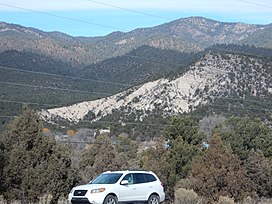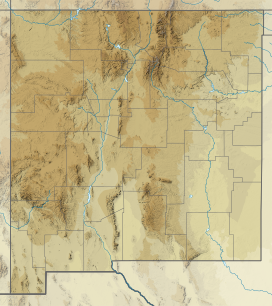| Picuris Mountains | |
|---|---|
 Picuris Mountains north of Picuris Pueblo, New Mexico Picuris Mountains north of Picuris Pueblo, New Mexico | |
| Highest point | |
| Peak | 10,801 ft (3,292 m), Picuris Peak |
| Dimensions | |
| Length | 15 mi (24 km) east-west |
| Width | 10 mi (16 km) north-south |
| Naming | |
| Etymology | Keres Pee-koo-ree-a, "those who paint" |
| Geography | |
 | |
| Country | United States |
| State | New Mexico |
| Range coordinates | 36°15′N 105°42′W / 36.250°N 105.700°W / 36.250; -105.700 |
The Picuris Mountains are a mountain range in northern New Mexico. They are considered a subrange of the Sangre de Cristo Mountains.
Geography
The mountains are located to the east of Dixon and surround Picuris Pueblo to the west, north, and east. The range resembles a triangle with its base to the east, along the valley of the Rio Grande del Rancho. The northwest face lies along the valley of the Rio Grande and the southern face lies along Rio Pueblo and Embudo Creek.
History
The area was first visited by Europeans on July 13, 1598, when Juan de Oñate visited Picuris Pueblo.
Geology
The range is underlain by Precambrian rock beds of the Hondo Group and Vadito Group. It is the namesake for the Picuris orogeny.
Economy
Mining has been historically important in the Picuris Mountains. The Harding Pegmatite Mine was operated off and on from about 1900 to 1958, when it was donated to the University of New Mexico as an outdoor geological laboratory. At one time, the mine made New Mexico the leading producer of beryllium among the United States. Copper has been mined at Copper Hill north of the Harding Mine. Other commodities historically mined in the range include tungsten, optical calcite, bismuth, and aluminosilicates. As of 2004, the MICA mine was the only producer of muscovite west of the Appalachian Mountains.
See also
References
- ^ Julyan, Robert (1998). The Place Names of New Mexico (2 ed.). Albuquerque: University of New Mexico Press. p. 266. ISBN 0-8263-1689-1.
- Jones, James V. III; Daniel, Christopher G.; Frei, Dirk; Thrane, Kristine (2011). "Revised regional correlations and tectonic implications of Paleoproterozoic and Mesoproterozoic metasedimentary rocks in northern New Mexico, USA: New findings from detrital zircon studies of the Hondo Group, Vadito Group, and Marqueñas Formation". Geosphere. 7 (4): 974–991. doi:10.1130/GES00614.1. Retrieved 15 April 2020.
- Jahns, Richard H.; Ewing, Rodney C. (1976). "The Harding Mine Taos County New Mexico" (PDF). New Mexico Geological Society Field Conference Series. 27: 263.
- McLemore, V. T.; Mullen, K. E. (2004). "Mineral resources in Taos County, New Mexico" (PDF). New Mexico Geological Society Field Conference Series. 55: 383–390. Retrieved 6 July 2022.
This New Mexico state location article is a stub. You can help Misplaced Pages by expanding it. |